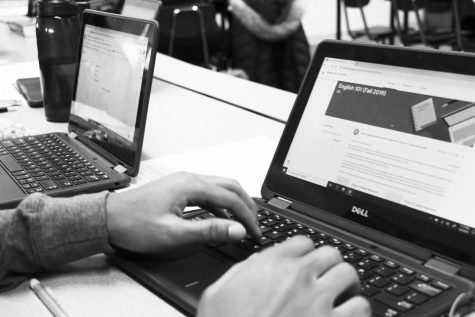District to expand use of Google Classroom
December 13, 2019
As Billy types the last sentence of his English essay on Google Classroom, he sends the rough draft to his teacher for corrections. His teacher responds and leaves comments on his paper conveniently on a sidebar. With confidence, Billy closes his laptop knowing his essay is finished all thanks to the convenience of Google Classroom.
As the district introduces the new platform of Google Classroom, there will be more opportunities to educate teachers on how to use this tool to enrich their students’ education.
“Every month there are different opportunities for teachers to come to sessions and learn how to use and practice new technology such as Google before they bring it to the classroom,” Laura Weed, district director of digital learning and innovation, said.
Even with additional opportunities given to teachers to become familiar with new programs, the way of training a district of this size takes time.
“We are such a big district. There are almost 27,000 students, 30 different schools, and over 1900 staff members. It’s hard to find time to meet with all of them and be able to get the opportunity to try and practice these new skills before they bring it to their classroom,” Weed said.
Although the new platform has introduced some challenges, the district is endorsing the change with open arms.
“We are looking at Google Classroom to be expanded. We are doing more to educate our teachers on Google, and it is a direction that is going to increase in the next few years,” Lane Abrell, district superintendent, said.
At building level, Principal Dave Stephens says a switch into technology won’t be mandatory.
“Teachers make decisions in the classroom. So, whether you use this technology or whether you use another type of technology probably depends on the teacher’s preference. When it comes to what is available to them such as materials given and training, the district can steer a teacher a certain way,” Stephens said.
In previous years, Office 365 has been the district’s primary software. Although Google Classroom has become more popular, this does not mean Office 365 will no longer be used.
“We like to use both. A lot of colleges and businesses use Office 365 so it’s good for students to be familiar with the way it works. When it comes to getting feedback from students and mini quizzes, that’s where Google is beneficial,” Weed said.
Throughout the past year, teachers have been using the platform more frequently and most feedback has been positive.
“I feel most of the curriculum will be done online and it’s definitely the future,” Mitizina Keane, English teacher, said. “Classroom keeps the kids up to date with what’s going on in the class. Anything I project or hand out can be put on there. It really puts responsibility on the student to check the site for what was posted.”
Likewise, most teachers also find Google Classroom’s ability to send out resources very effective to aid students with schoolwork.
“When I have a student absent, they can use the site as a resource to catch up on classwork that was missed,” Chandler Stich, math teacher, said.
As District 202 continually looks for new ways to enhance the curriculum, for Google Classroom to be used to its full capacity, the idea of assigning personal laptops to students has been considered.
“We have found researching other districts around us that have done that and found it might be better for us to get enough laptops during the school day that can be used but not necessarily you or another student takes home every night,” Abrell, said. According to Abrell, Districts such as Valley View, Indian Prairie, Naperville and Yorkville are leading the way for this new inclusion of technology both in the classroom and at home with one-on-one Chromebooks.
“We are learning from their mistakes and issues they have with the new laptops. For now, the district will only continue to drastically increase the number of laptops on carts in high schools, middle schools, and elementary schools,” Abrell said.
The issue of cost and practicality are the primary setbacks for not providing students personal Chromebooks. On the other hand, personal Chromebooks for students do hold many benefits.
“Most districts we’ve looked at students pay a fee to receive these laptops. The fee we would most likely apply is $100-$150 a year for four years. The positive of this is that the student can keep the laptop after they graduate and bring it to college or whatever they plan to do in life,” Abrell said.
Some students already have personal laptops, but if teachers knew all students all had individual computers, they could make lesson plans online to send home.
“I know other schools that give students their own laptops. When there are snow days, students can still do work assigned to them on their computers,” Emma Polanski, junior, said.
For now, while all students can’t be like Billy yet, they know that their district is looking for new ways to make learning more for efficient through the use of technology.




